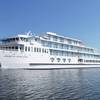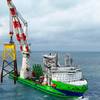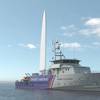When pioneering king crab fisherman Oscar Dyson of Kodiak had Jensen-designed 99 ft. Peggy Jo built back in 1966, Pacific Fisherman hailed her as "the first U.S. vessel ever built specifically to fish for King crab." She was big for her day - capable of carrying 100 pots and packing 12,000 live crab. The yellowing magazine copy tells us she was equipped with the latest electronics including "a loran set which enables the skipper to establish his bearings electronically." An earlier article trumpeted another innovation, "An unusual feature of Peggy Jo is the articulated hydraulic boom mounted in the middle of the main deck working area." Built at Martinolich Shipyard in Tacoma, the new vessel carried a 850 hp Caterpillar D-398 in her engine room.
But the old newspaper doesn't tell about Oscar Dyson's partner and the boat's engineer, Shelden "Nellie" Nelson or Joe's wife Peggy or their little daughter Peggy Jo for whom the boat was named. And it didn't tell about Dyson's step-son Doug Hoedel because he was just a 12-year-old kid all excited about the big new boat. But Dyson and Nellie and the kid would share huge lives in the Alaskan fisheries and those lives would be shaped and enriched by Peggy Jo. The "kid" is now 44 years old and an established fisherman still living in Kodiak and Anchorage, Alaska.
Doug said of the early years, "Those two men didn't give me any breaks but they taught me all I know about crab and pot fishing. The first summer Peggy Jo was fishing crab I was paid $10 a load to watch the baskets come off and keep tally. When I got out of high school they took me on the old way, as an apprentice, an extra man on deck, and they paid me 1/4 share for about a year. Then when they saw that I wouldn't give up they gave me a half-share."
Doug worked his way up through 3/4 share to full share. He bought and started fishing a 42-ft. Alaska seiner in 1977, but he still spent time on Peggy Jo. When his step-dad was away at Alaska Board of Fish and Game meetings, Nellie would run the boat. Always the young man was learning and the boat was earning her keep. Then came the collapse of the king crab stocks in 1984. "We took the boat down to Dakota Creek Shipyard and did the trawl conversion," Doug said.
When the boat came out of the yard in 1985, the boy who worked his way up from tallying baskets of crab, took command. The boat was a pioneer in the Shelikof joint venture pollock fishery just as it had been in the shrimp bottom trawl fishery back in the 1970s. With Oscar Dyson's death in 1995, the vessel continued in the family with ownership shared by Doug's mom Peggy Dyson and Nellie, now up in his eighties. Peggy is well known to fishermen as the weather woman on the SSB out of "Kodiak WB29, The voice of the fleet."
Most recently the family boat has been skippered by Brian Beaver. In the 32 years since the Pacific Fisherman magazine welcomed her to the industry, she has paid a lot of dues, helped raise a few families and trained a bunch of good skippers like Bart Eaton, Danny Olsen, Ron Jolen and Doug's brother Robbie. It was time she got some good R&R.
Back in 1990, Doug had a Jensen-designed, Cummins-powered, 58-ft. limit seiner built by Fred Wahl. He went back to Fred and the two men agreed to buy the boat from the older generation and give it new life. Doug is a strong believer in the importance of fishing history and had named his limit seiner Tradition to honor the legacy.
The Cummins KTA19 and the two Cummins auxiliaries had served well in the limit seiner and Cummins dealer Tom Curry of Curry Marine in Newport Oregon is well known for good service. So the new partners decided on a repower from the original 850 hp engine to a Cummins KTA38 M1 delivering 1,100 hp into a TwinDisc 5301 5:1 and turning the existing three-blade 80-in. prop that will likely be repitched as the project proceeds.
"The boat was very heavy built with 3/8 in. steel and the ultrasound testing showed the hull still in good shape. We are sandblasting every void, ballast tank and fishhold. We'll add a new pilot house and Yaquina trawl winches," said Doug.
With just about everything on the boat being rebuilt or replaced, Doug is asked why not build a new boat? He has a ready answer, "It's tradition, I've been on that boat in 50-ft. seas in the Bering Sea and it's a fine hull, so why change what works?"
Subscribe for
Maritime Reporter E-News
Maritime Reporter E-News is the maritime industry's largest circulation and most authoritative ENews Service, delivered to your Email five times per week













